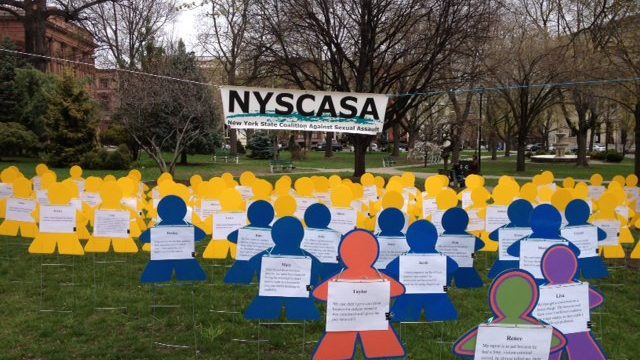This blog post was written by New York State Coalition Against Sexual Assault (NYSCASA) for our 2018 PowHer The Vote campaign.
The New York State Coalition Against Sexual Assault (NYSCASA) is a statewide anti-sexual assault coalition dedicated to ending sexual violence and exploitation, and to addressing the impacts of sexual assault. We have member based community rape crisis programs who deliver sexual assault crisis intervention and prevention services throughout the state. Sexual violence is primarily motivated by a desire to exert power and control and is a symptom of gender disparity and other social inequities. We understand that violence is rooted in oppression and that we must work to dismantle all forms of oppression. This means that racism, sexism, homophobia, transphobia, classism, ableism, nativism and other forms of oppression must be eliminated to ultimately end sexual violence.
In the U.S., one in three women and one in six men experienced some form of contact sexual violence in their lifetime.1 In addition, one in five women and one in 71 men will be raped at some point in their lives.2 Furthermore one in four girls and one in six boys will be sexually abused before they turn 18 years old.3 Additionally, 20% – 25% of college women and 15% of college men are victims of forced sex during their time in college.4 These statistics demonstrate just how prevalent sexual assault is. This issue is important because it impacts all of us. Many people have actually experienced sexual violence or they have a loved one who has experienced sexual violence. Sexual violence can be experienced at any stage in life and can cause effects such as depression, post-traumatic stress disorder, anxiety disorder, attempted suicide or completed suicide.
Although we can’t rely on legislation alone to end sexual violence, it is very important that we elect officials who are dedicated to ending sexual violence and other forms of interpersonal violence. It is important to elect officials who believe in creating equality and who want to strengthen civil rights for all people especially those who have had their rights wrongfully stripped away. It is important that we elect officials who don’t disparage survivors of sexual violence and other forms of interpersonal violence. It is also important to elect officials who will invest in victim services that are high quality, comprehensive, coordinated, culturally appropriate, and widely accessible. Additionally, it’s important that we elect officials who will invest in efforts that can prevent sexual violence from happening in the first place. Prevention efforts should be undertaken with the goal of minimizing the risk factors for perpetration and increasing protective factors. Cultural and legislative change will be required to ultimately end sexual violence.
Notes
-
Smith, S. G., Chen, J., Basile, K. C., Gilbert, L. K., Merrick, M. T., Patel, N., … Jain, A. (2017). The National Intimate Partner and Sexual Violence Survey (NISVS): 2010-2012 state report. Retrieved from the Centers for Disease Control and Prevention, National Center for Injury Prevention and Control: https://www.cdc.gov/violenceprevention/pdf/NISVS-StateReportBook.pdf.
-
Black, M. C., Basile, K. C., Breiding, M. J., Smith, S .G., Walters, M. L., Merrick, M. T., Stevens, M. R. (2011). The National Intimate Partner and Sexual Violence Survey (NISVS): 2010 summary report. Retrieved from the Centers for Disease Control and Prevention, National Center for Injury Prevention and Control: http://www.cdc.gov/ViolencePrevention/pdf/NISVS_Report2010-a.pdf.
-
Finkelhor, D., Hotaling, G., Lewis, I. A., & Smith, C. (1990). Sexual abuse in a national survey of adult men and women: Prevalence, characteristics and risk factors. Child Abuse & Neglect 14, 19-28. doi:10.1016/0145-2134(90)90077-7.
-
Cullen, F., Fisher, B., & Turner, M., The sexual victimization of college women (NCJ 182369). (2000). Retrieved from the U.S. Department of Justice, Office of Justice Programs, National Institute of Justice: https://www.ncjrs.gov/pdffiles1/nij/182369.pdf.


